Reflection on Indigenous Education and Employment Policies
VerifiedAdded on 2023/03/31
|9
|1816
|460
AI Summary
This essay reflects on two education and employment policies related to the indigenous population and the group task that focused on engaging participation of indigenous people in the education workforce.
Contribute Materials
Your contribution can guide someone’s learning journey. Share your
documents today.
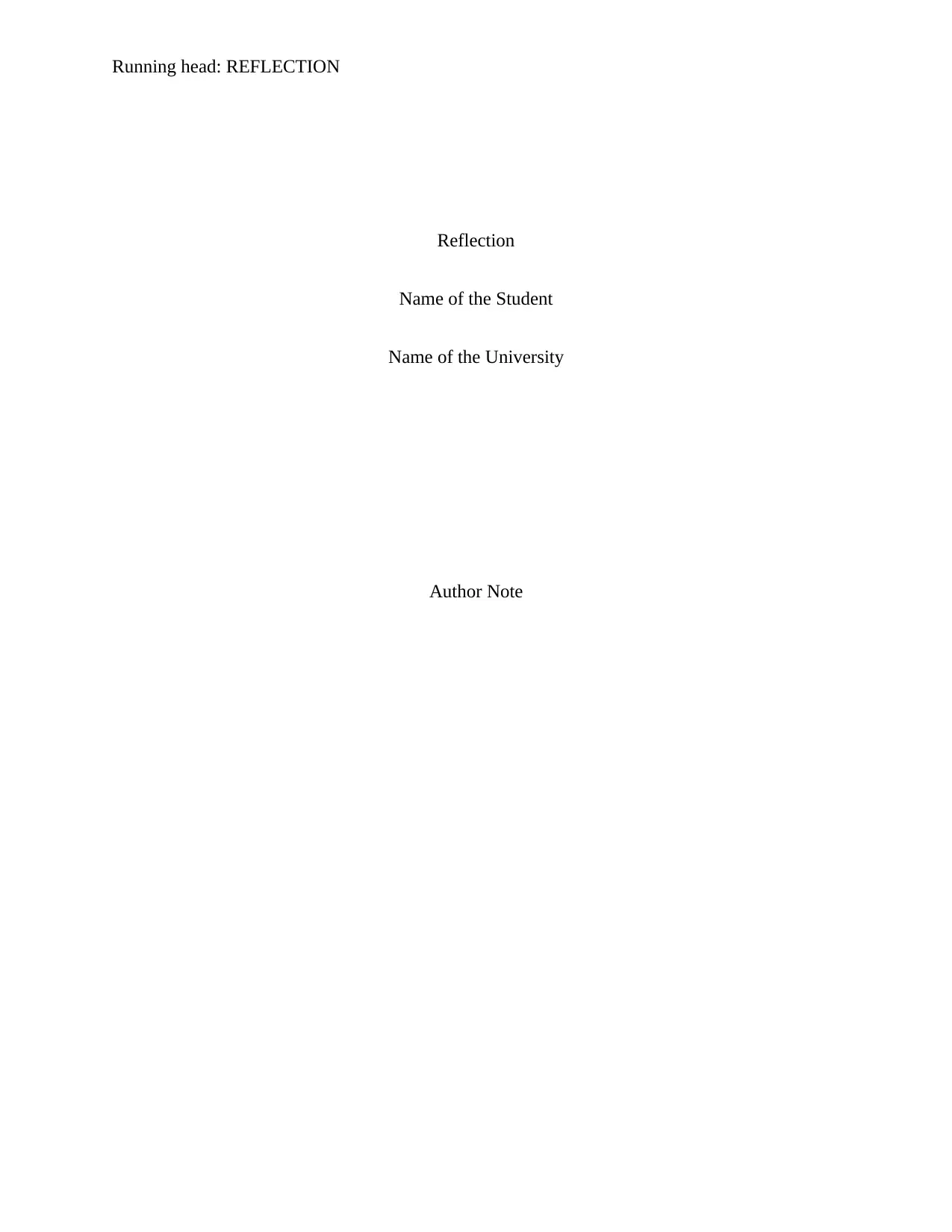
Running head: REFLECTION
Reflection
Name of the Student
Name of the University
Author Note
Reflection
Name of the Student
Name of the University
Author Note
Secure Best Marks with AI Grader
Need help grading? Try our AI Grader for instant feedback on your assignments.
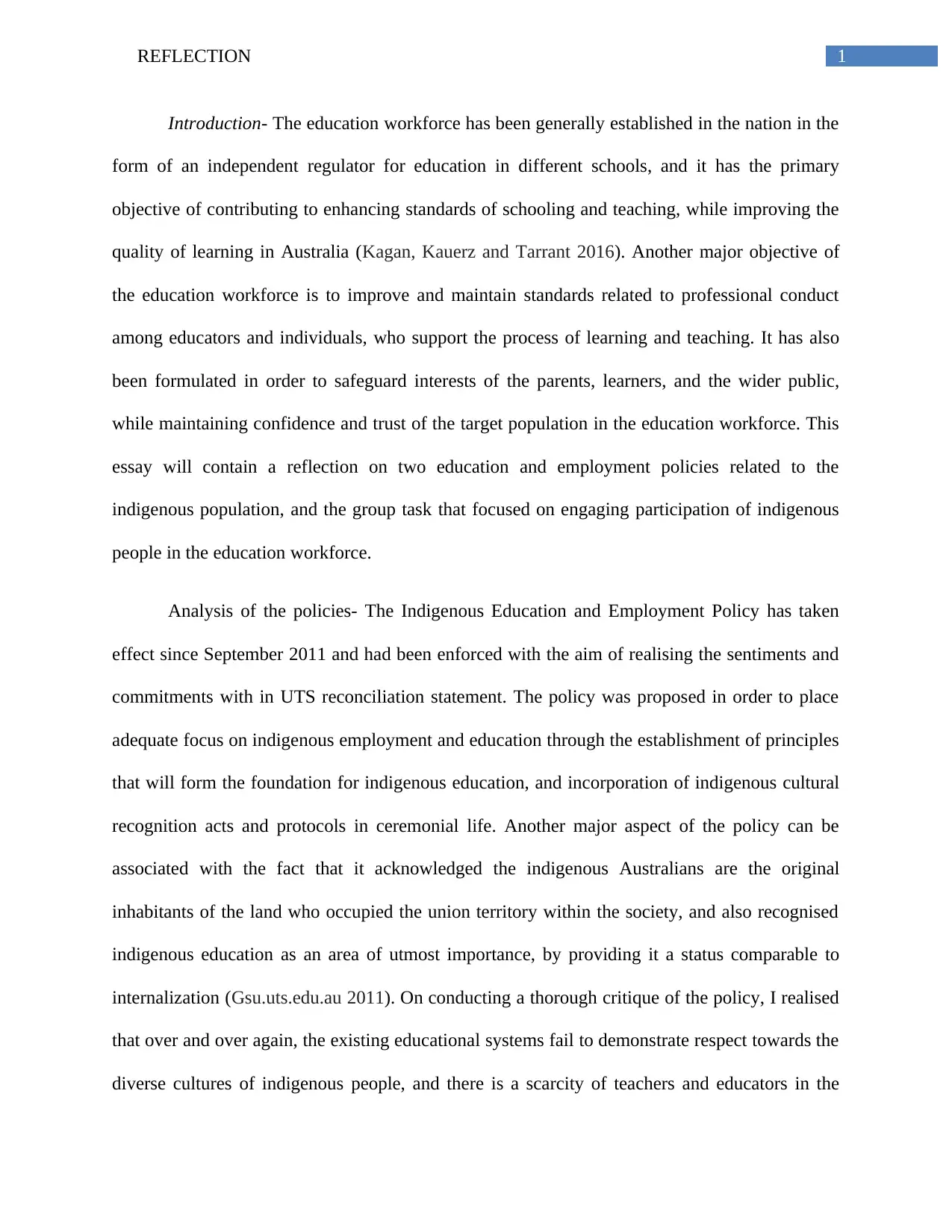
1REFLECTION
Introduction- The education workforce has been generally established in the nation in the
form of an independent regulator for education in different schools, and it has the primary
objective of contributing to enhancing standards of schooling and teaching, while improving the
quality of learning in Australia (Kagan, Kauerz and Tarrant 2016). Another major objective of
the education workforce is to improve and maintain standards related to professional conduct
among educators and individuals, who support the process of learning and teaching. It has also
been formulated in order to safeguard interests of the parents, learners, and the wider public,
while maintaining confidence and trust of the target population in the education workforce. This
essay will contain a reflection on two education and employment policies related to the
indigenous population, and the group task that focused on engaging participation of indigenous
people in the education workforce.
Analysis of the policies- The Indigenous Education and Employment Policy has taken
effect since September 2011 and had been enforced with the aim of realising the sentiments and
commitments with in UTS reconciliation statement. The policy was proposed in order to place
adequate focus on indigenous employment and education through the establishment of principles
that will form the foundation for indigenous education, and incorporation of indigenous cultural
recognition acts and protocols in ceremonial life. Another major aspect of the policy can be
associated with the fact that it acknowledged the indigenous Australians are the original
inhabitants of the land who occupied the union territory within the society, and also recognised
indigenous education as an area of utmost importance, by providing it a status comparable to
internalization (Gsu.uts.edu.au 2011). On conducting a thorough critique of the policy, I realised
that over and over again, the existing educational systems fail to demonstrate respect towards the
diverse cultures of indigenous people, and there is a scarcity of teachers and educators in the
Introduction- The education workforce has been generally established in the nation in the
form of an independent regulator for education in different schools, and it has the primary
objective of contributing to enhancing standards of schooling and teaching, while improving the
quality of learning in Australia (Kagan, Kauerz and Tarrant 2016). Another major objective of
the education workforce is to improve and maintain standards related to professional conduct
among educators and individuals, who support the process of learning and teaching. It has also
been formulated in order to safeguard interests of the parents, learners, and the wider public,
while maintaining confidence and trust of the target population in the education workforce. This
essay will contain a reflection on two education and employment policies related to the
indigenous population, and the group task that focused on engaging participation of indigenous
people in the education workforce.
Analysis of the policies- The Indigenous Education and Employment Policy has taken
effect since September 2011 and had been enforced with the aim of realising the sentiments and
commitments with in UTS reconciliation statement. The policy was proposed in order to place
adequate focus on indigenous employment and education through the establishment of principles
that will form the foundation for indigenous education, and incorporation of indigenous cultural
recognition acts and protocols in ceremonial life. Another major aspect of the policy can be
associated with the fact that it acknowledged the indigenous Australians are the original
inhabitants of the land who occupied the union territory within the society, and also recognised
indigenous education as an area of utmost importance, by providing it a status comparable to
internalization (Gsu.uts.edu.au 2011). On conducting a thorough critique of the policy, I realised
that over and over again, the existing educational systems fail to demonstrate respect towards the
diverse cultures of indigenous people, and there is a scarcity of teachers and educators in the
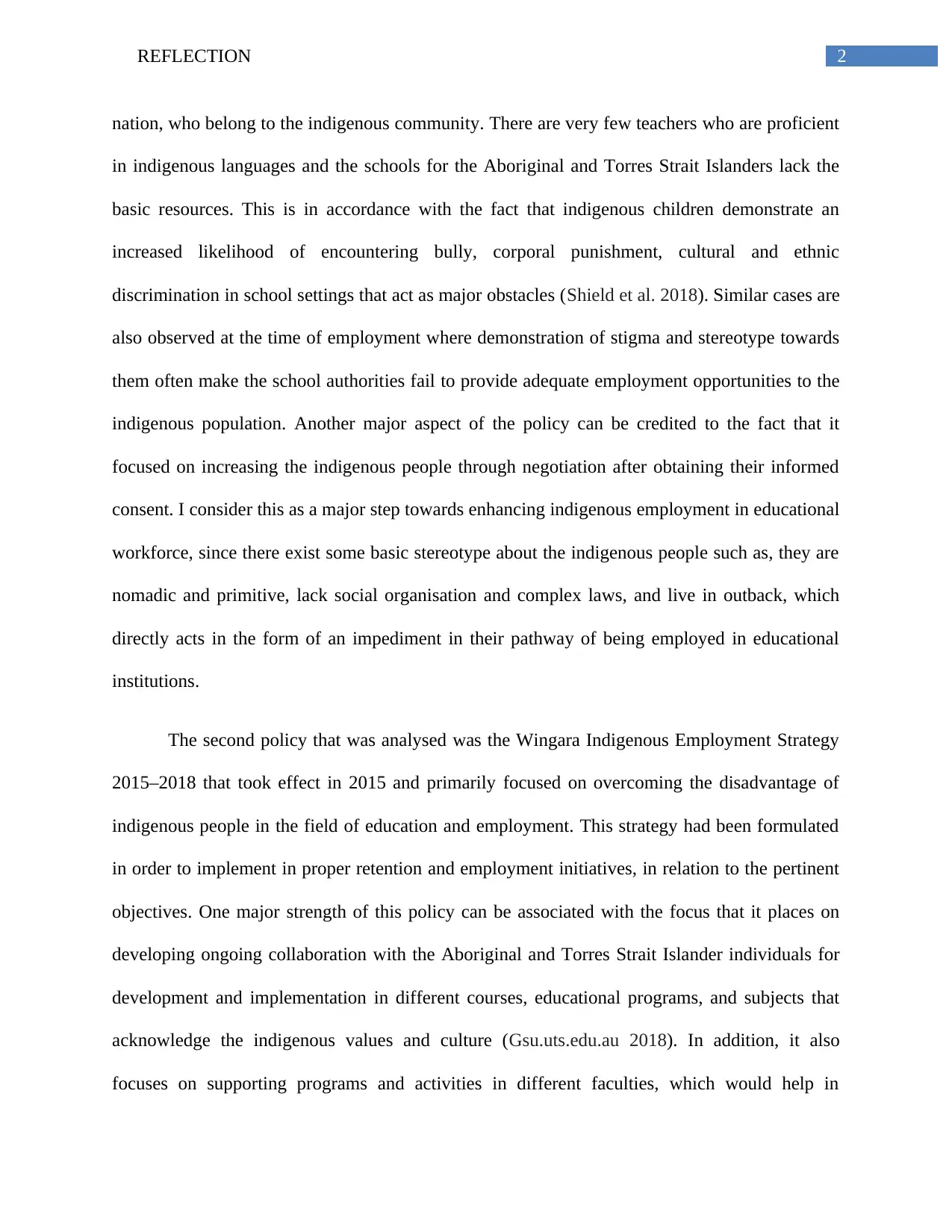
2REFLECTION
nation, who belong to the indigenous community. There are very few teachers who are proficient
in indigenous languages and the schools for the Aboriginal and Torres Strait Islanders lack the
basic resources. This is in accordance with the fact that indigenous children demonstrate an
increased likelihood of encountering bully, corporal punishment, cultural and ethnic
discrimination in school settings that act as major obstacles (Shield et al. 2018). Similar cases are
also observed at the time of employment where demonstration of stigma and stereotype towards
them often make the school authorities fail to provide adequate employment opportunities to the
indigenous population. Another major aspect of the policy can be credited to the fact that it
focused on increasing the indigenous people through negotiation after obtaining their informed
consent. I consider this as a major step towards enhancing indigenous employment in educational
workforce, since there exist some basic stereotype about the indigenous people such as, they are
nomadic and primitive, lack social organisation and complex laws, and live in outback, which
directly acts in the form of an impediment in their pathway of being employed in educational
institutions.
The second policy that was analysed was the Wingara Indigenous Employment Strategy
2015–2018 that took effect in 2015 and primarily focused on overcoming the disadvantage of
indigenous people in the field of education and employment. This strategy had been formulated
in order to implement in proper retention and employment initiatives, in relation to the pertinent
objectives. One major strength of this policy can be associated with the focus that it places on
developing ongoing collaboration with the Aboriginal and Torres Strait Islander individuals for
development and implementation in different courses, educational programs, and subjects that
acknowledge the indigenous values and culture (Gsu.uts.edu.au 2018). In addition, it also
focuses on supporting programs and activities in different faculties, which would help in
nation, who belong to the indigenous community. There are very few teachers who are proficient
in indigenous languages and the schools for the Aboriginal and Torres Strait Islanders lack the
basic resources. This is in accordance with the fact that indigenous children demonstrate an
increased likelihood of encountering bully, corporal punishment, cultural and ethnic
discrimination in school settings that act as major obstacles (Shield et al. 2018). Similar cases are
also observed at the time of employment where demonstration of stigma and stereotype towards
them often make the school authorities fail to provide adequate employment opportunities to the
indigenous population. Another major aspect of the policy can be credited to the fact that it
focused on increasing the indigenous people through negotiation after obtaining their informed
consent. I consider this as a major step towards enhancing indigenous employment in educational
workforce, since there exist some basic stereotype about the indigenous people such as, they are
nomadic and primitive, lack social organisation and complex laws, and live in outback, which
directly acts in the form of an impediment in their pathway of being employed in educational
institutions.
The second policy that was analysed was the Wingara Indigenous Employment Strategy
2015–2018 that took effect in 2015 and primarily focused on overcoming the disadvantage of
indigenous people in the field of education and employment. This strategy had been formulated
in order to implement in proper retention and employment initiatives, in relation to the pertinent
objectives. One major strength of this policy can be associated with the focus that it places on
developing ongoing collaboration with the Aboriginal and Torres Strait Islander individuals for
development and implementation in different courses, educational programs, and subjects that
acknowledge the indigenous values and culture (Gsu.uts.edu.au 2018). In addition, it also
focuses on supporting programs and activities in different faculties, which would help in
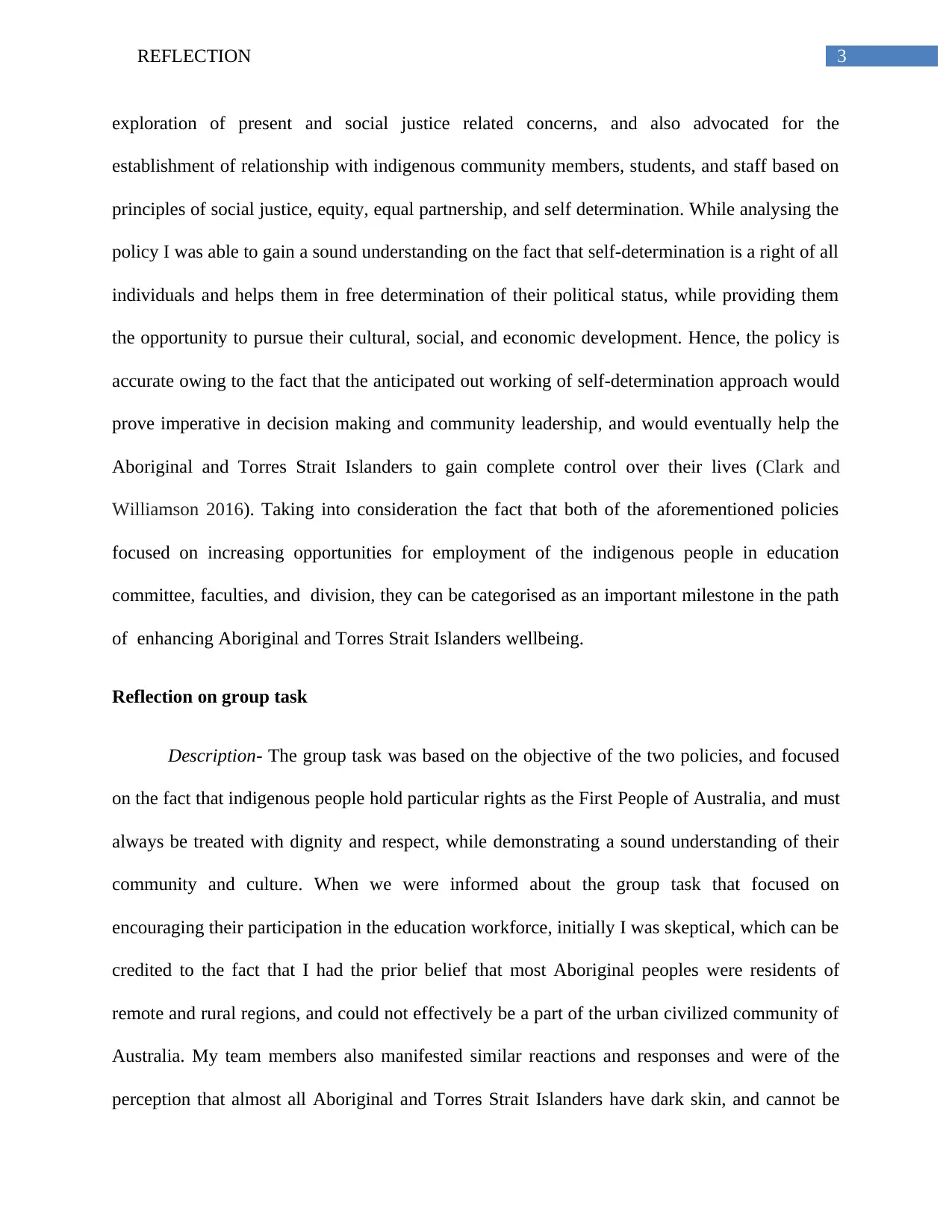
3REFLECTION
exploration of present and social justice related concerns, and also advocated for the
establishment of relationship with indigenous community members, students, and staff based on
principles of social justice, equity, equal partnership, and self determination. While analysing the
policy I was able to gain a sound understanding on the fact that self-determination is a right of all
individuals and helps them in free determination of their political status, while providing them
the opportunity to pursue their cultural, social, and economic development. Hence, the policy is
accurate owing to the fact that the anticipated out working of self-determination approach would
prove imperative in decision making and community leadership, and would eventually help the
Aboriginal and Torres Strait Islanders to gain complete control over their lives (Clark and
Williamson 2016). Taking into consideration the fact that both of the aforementioned policies
focused on increasing opportunities for employment of the indigenous people in education
committee, faculties, and division, they can be categorised as an important milestone in the path
of enhancing Aboriginal and Torres Strait Islanders wellbeing.
Reflection on group task
Description- The group task was based on the objective of the two policies, and focused
on the fact that indigenous people hold particular rights as the First People of Australia, and must
always be treated with dignity and respect, while demonstrating a sound understanding of their
community and culture. When we were informed about the group task that focused on
encouraging their participation in the education workforce, initially I was skeptical, which can be
credited to the fact that I had the prior belief that most Aboriginal peoples were residents of
remote and rural regions, and could not effectively be a part of the urban civilized community of
Australia. My team members also manifested similar reactions and responses and were of the
perception that almost all Aboriginal and Torres Strait Islanders have dark skin, and cannot be
exploration of present and social justice related concerns, and also advocated for the
establishment of relationship with indigenous community members, students, and staff based on
principles of social justice, equity, equal partnership, and self determination. While analysing the
policy I was able to gain a sound understanding on the fact that self-determination is a right of all
individuals and helps them in free determination of their political status, while providing them
the opportunity to pursue their cultural, social, and economic development. Hence, the policy is
accurate owing to the fact that the anticipated out working of self-determination approach would
prove imperative in decision making and community leadership, and would eventually help the
Aboriginal and Torres Strait Islanders to gain complete control over their lives (Clark and
Williamson 2016). Taking into consideration the fact that both of the aforementioned policies
focused on increasing opportunities for employment of the indigenous people in education
committee, faculties, and division, they can be categorised as an important milestone in the path
of enhancing Aboriginal and Torres Strait Islanders wellbeing.
Reflection on group task
Description- The group task was based on the objective of the two policies, and focused
on the fact that indigenous people hold particular rights as the First People of Australia, and must
always be treated with dignity and respect, while demonstrating a sound understanding of their
community and culture. When we were informed about the group task that focused on
encouraging their participation in the education workforce, initially I was skeptical, which can be
credited to the fact that I had the prior belief that most Aboriginal peoples were residents of
remote and rural regions, and could not effectively be a part of the urban civilized community of
Australia. My team members also manifested similar reactions and responses and were of the
perception that almost all Aboriginal and Torres Strait Islanders have dark skin, and cannot be
Secure Best Marks with AI Grader
Need help grading? Try our AI Grader for instant feedback on your assignments.
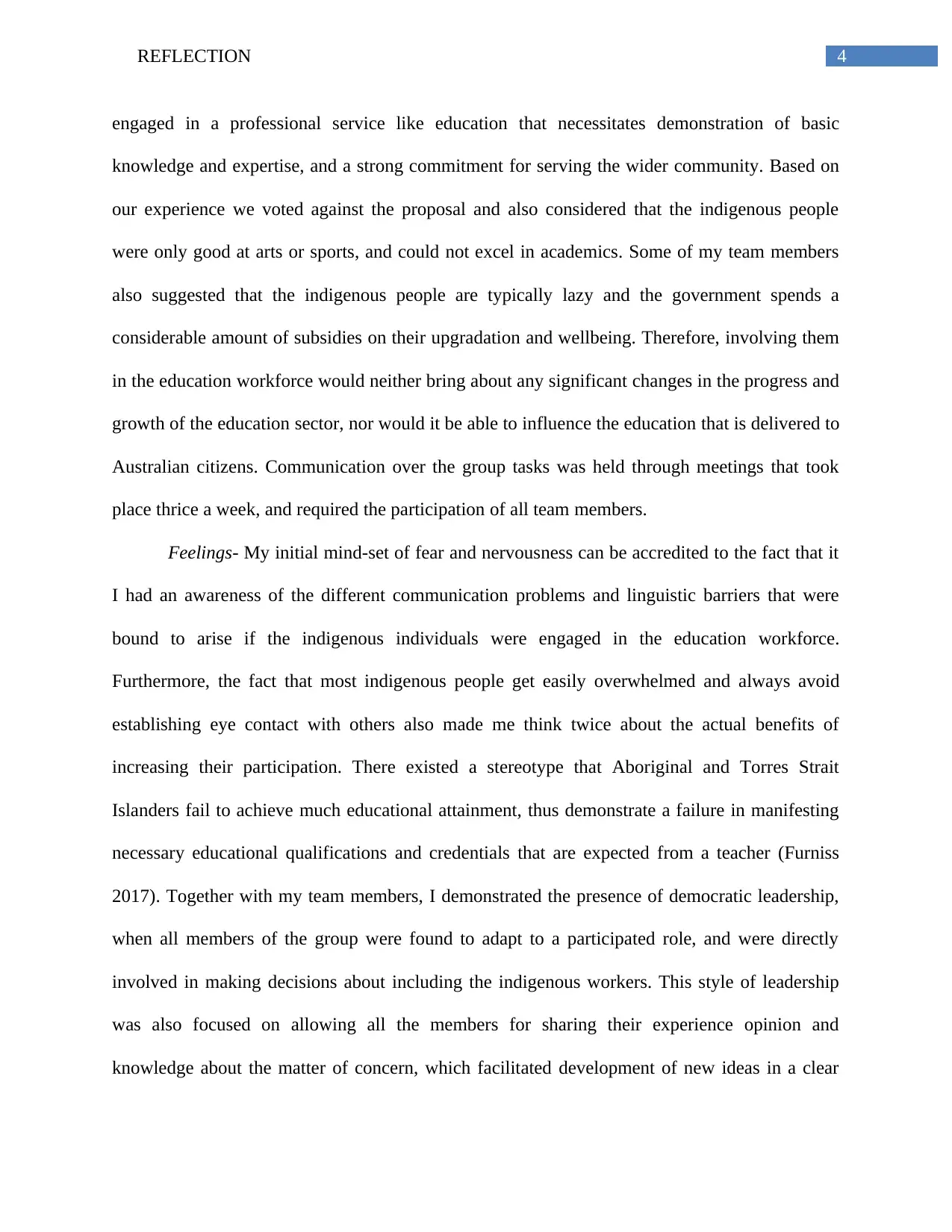
4REFLECTION
engaged in a professional service like education that necessitates demonstration of basic
knowledge and expertise, and a strong commitment for serving the wider community. Based on
our experience we voted against the proposal and also considered that the indigenous people
were only good at arts or sports, and could not excel in academics. Some of my team members
also suggested that the indigenous people are typically lazy and the government spends a
considerable amount of subsidies on their upgradation and wellbeing. Therefore, involving them
in the education workforce would neither bring about any significant changes in the progress and
growth of the education sector, nor would it be able to influence the education that is delivered to
Australian citizens. Communication over the group tasks was held through meetings that took
place thrice a week, and required the participation of all team members.
Feelings- My initial mind-set of fear and nervousness can be accredited to the fact that it
I had an awareness of the different communication problems and linguistic barriers that were
bound to arise if the indigenous individuals were engaged in the education workforce.
Furthermore, the fact that most indigenous people get easily overwhelmed and always avoid
establishing eye contact with others also made me think twice about the actual benefits of
increasing their participation. There existed a stereotype that Aboriginal and Torres Strait
Islanders fail to achieve much educational attainment, thus demonstrate a failure in manifesting
necessary educational qualifications and credentials that are expected from a teacher (Furniss
2017). Together with my team members, I demonstrated the presence of democratic leadership,
when all members of the group were found to adapt to a participated role, and were directly
involved in making decisions about including the indigenous workers. This style of leadership
was also focused on allowing all the members for sharing their experience opinion and
knowledge about the matter of concern, which facilitated development of new ideas in a clear
engaged in a professional service like education that necessitates demonstration of basic
knowledge and expertise, and a strong commitment for serving the wider community. Based on
our experience we voted against the proposal and also considered that the indigenous people
were only good at arts or sports, and could not excel in academics. Some of my team members
also suggested that the indigenous people are typically lazy and the government spends a
considerable amount of subsidies on their upgradation and wellbeing. Therefore, involving them
in the education workforce would neither bring about any significant changes in the progress and
growth of the education sector, nor would it be able to influence the education that is delivered to
Australian citizens. Communication over the group tasks was held through meetings that took
place thrice a week, and required the participation of all team members.
Feelings- My initial mind-set of fear and nervousness can be accredited to the fact that it
I had an awareness of the different communication problems and linguistic barriers that were
bound to arise if the indigenous individuals were engaged in the education workforce.
Furthermore, the fact that most indigenous people get easily overwhelmed and always avoid
establishing eye contact with others also made me think twice about the actual benefits of
increasing their participation. There existed a stereotype that Aboriginal and Torres Strait
Islanders fail to achieve much educational attainment, thus demonstrate a failure in manifesting
necessary educational qualifications and credentials that are expected from a teacher (Furniss
2017). Together with my team members, I demonstrated the presence of democratic leadership,
when all members of the group were found to adapt to a participated role, and were directly
involved in making decisions about including the indigenous workers. This style of leadership
was also focused on allowing all the members for sharing their experience opinion and
knowledge about the matter of concern, which facilitated development of new ideas in a clear
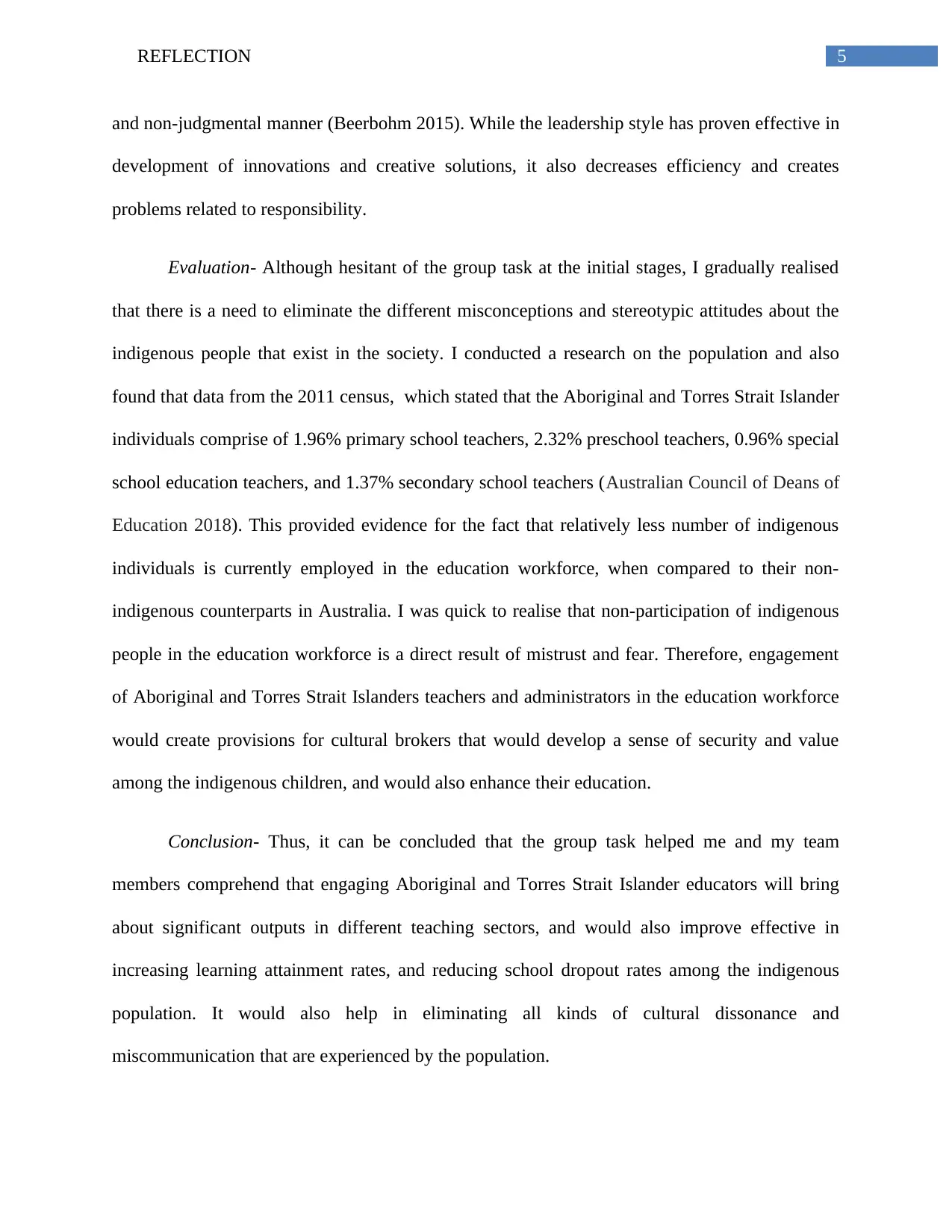
5REFLECTION
and non-judgmental manner (Beerbohm 2015). While the leadership style has proven effective in
development of innovations and creative solutions, it also decreases efficiency and creates
problems related to responsibility.
Evaluation- Although hesitant of the group task at the initial stages, I gradually realised
that there is a need to eliminate the different misconceptions and stereotypic attitudes about the
indigenous people that exist in the society. I conducted a research on the population and also
found that data from the 2011 census, which stated that the Aboriginal and Torres Strait Islander
individuals comprise of 1.96% primary school teachers, 2.32% preschool teachers, 0.96% special
school education teachers, and 1.37% secondary school teachers (Australian Council of Deans of
Education 2018). This provided evidence for the fact that relatively less number of indigenous
individuals is currently employed in the education workforce, when compared to their non-
indigenous counterparts in Australia. I was quick to realise that non-participation of indigenous
people in the education workforce is a direct result of mistrust and fear. Therefore, engagement
of Aboriginal and Torres Strait Islanders teachers and administrators in the education workforce
would create provisions for cultural brokers that would develop a sense of security and value
among the indigenous children, and would also enhance their education.
Conclusion- Thus, it can be concluded that the group task helped me and my team
members comprehend that engaging Aboriginal and Torres Strait Islander educators will bring
about significant outputs in different teaching sectors, and would also improve effective in
increasing learning attainment rates, and reducing school dropout rates among the indigenous
population. It would also help in eliminating all kinds of cultural dissonance and
miscommunication that are experienced by the population.
and non-judgmental manner (Beerbohm 2015). While the leadership style has proven effective in
development of innovations and creative solutions, it also decreases efficiency and creates
problems related to responsibility.
Evaluation- Although hesitant of the group task at the initial stages, I gradually realised
that there is a need to eliminate the different misconceptions and stereotypic attitudes about the
indigenous people that exist in the society. I conducted a research on the population and also
found that data from the 2011 census, which stated that the Aboriginal and Torres Strait Islander
individuals comprise of 1.96% primary school teachers, 2.32% preschool teachers, 0.96% special
school education teachers, and 1.37% secondary school teachers (Australian Council of Deans of
Education 2018). This provided evidence for the fact that relatively less number of indigenous
individuals is currently employed in the education workforce, when compared to their non-
indigenous counterparts in Australia. I was quick to realise that non-participation of indigenous
people in the education workforce is a direct result of mistrust and fear. Therefore, engagement
of Aboriginal and Torres Strait Islanders teachers and administrators in the education workforce
would create provisions for cultural brokers that would develop a sense of security and value
among the indigenous children, and would also enhance their education.
Conclusion- Thus, it can be concluded that the group task helped me and my team
members comprehend that engaging Aboriginal and Torres Strait Islander educators will bring
about significant outputs in different teaching sectors, and would also improve effective in
increasing learning attainment rates, and reducing school dropout rates among the indigenous
population. It would also help in eliminating all kinds of cultural dissonance and
miscommunication that are experienced by the population.
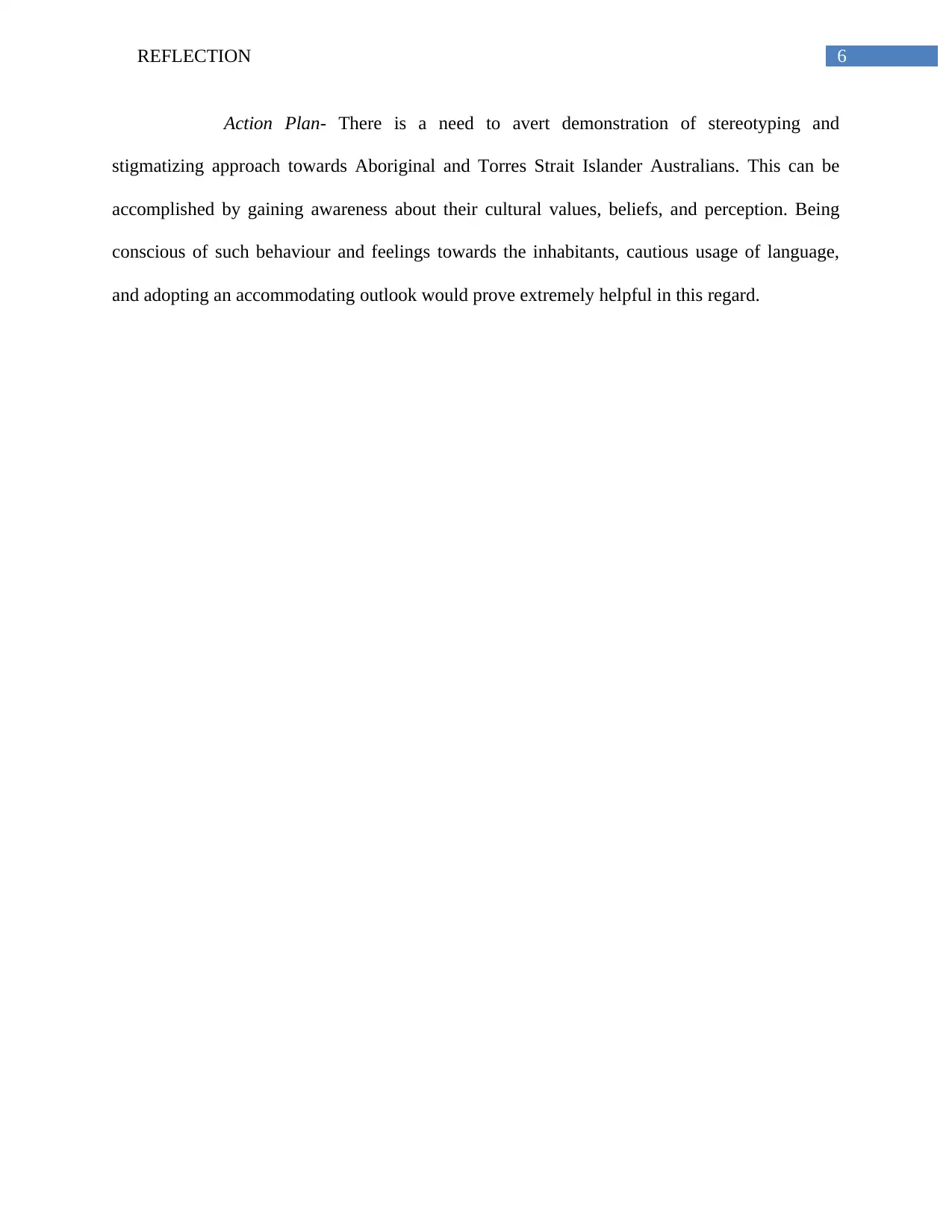
6REFLECTION
Action Plan- There is a need to avert demonstration of stereotyping and
stigmatizing approach towards Aboriginal and Torres Strait Islander Australians. This can be
accomplished by gaining awareness about their cultural values, beliefs, and perception. Being
conscious of such behaviour and feelings towards the inhabitants, cautious usage of language,
and adopting an accommodating outlook would prove extremely helpful in this regard.
Action Plan- There is a need to avert demonstration of stereotyping and
stigmatizing approach towards Aboriginal and Torres Strait Islander Australians. This can be
accomplished by gaining awareness about their cultural values, beliefs, and perception. Being
conscious of such behaviour and feelings towards the inhabitants, cautious usage of language,
and adopting an accommodating outlook would prove extremely helpful in this regard.
Paraphrase This Document
Need a fresh take? Get an instant paraphrase of this document with our AI Paraphraser
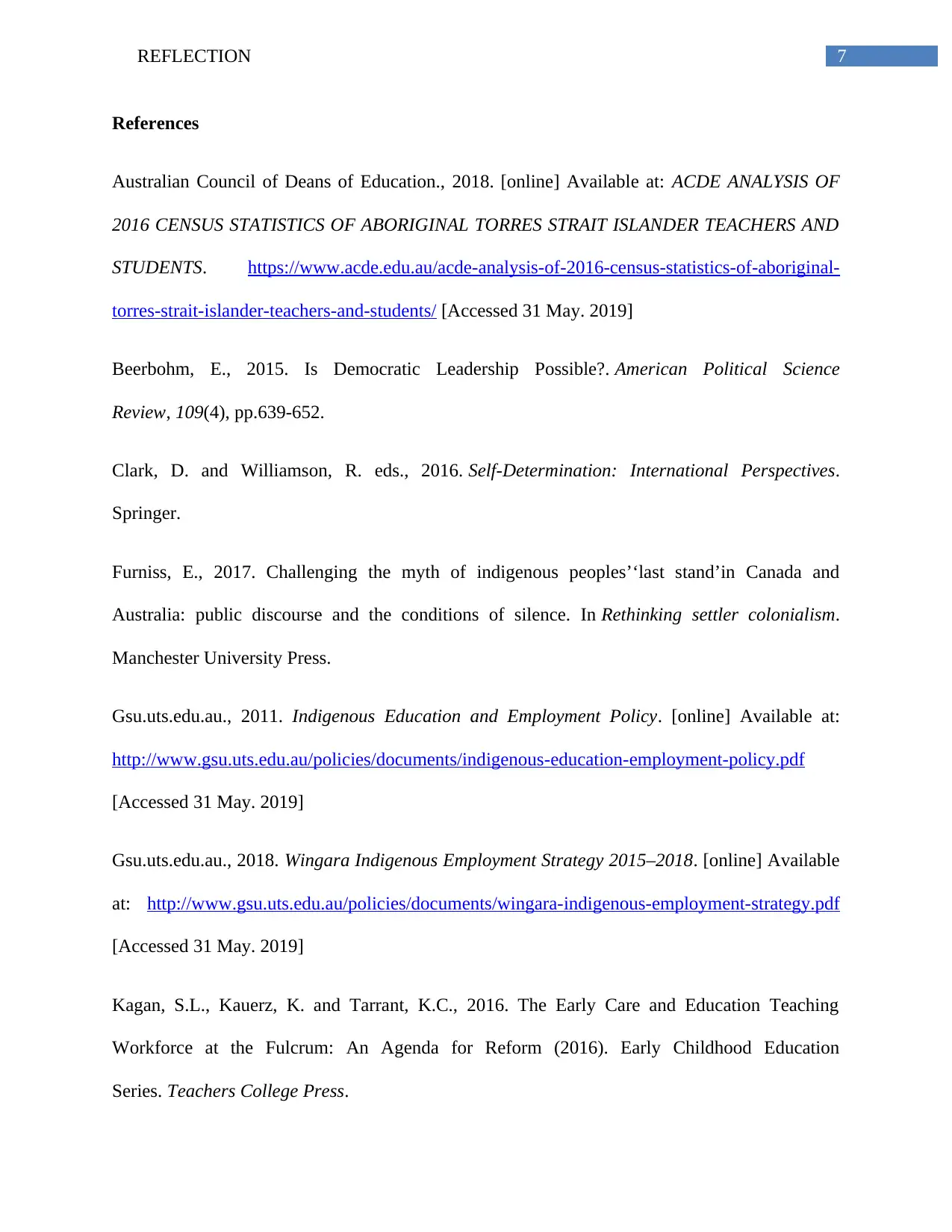
7REFLECTION
References
Australian Council of Deans of Education., 2018. [online] Available at: ACDE ANALYSIS OF
2016 CENSUS STATISTICS OF ABORIGINAL TORRES STRAIT ISLANDER TEACHERS AND
STUDENTS. https://www.acde.edu.au/acde-analysis-of-2016-census-statistics-of-aboriginal-
torres-strait-islander-teachers-and-students/ [Accessed 31 May. 2019]
Beerbohm, E., 2015. Is Democratic Leadership Possible?. American Political Science
Review, 109(4), pp.639-652.
Clark, D. and Williamson, R. eds., 2016. Self-Determination: International Perspectives.
Springer.
Furniss, E., 2017. Challenging the myth of indigenous peoples’‘last stand’in Canada and
Australia: public discourse and the conditions of silence. In Rethinking settler colonialism.
Manchester University Press.
Gsu.uts.edu.au., 2011. Indigenous Education and Employment Policy. [online] Available at:
http://www.gsu.uts.edu.au/policies/documents/indigenous-education-employment-policy.pdf
[Accessed 31 May. 2019]
Gsu.uts.edu.au., 2018. Wingara Indigenous Employment Strategy 2015–2018. [online] Available
at: http://www.gsu.uts.edu.au/policies/documents/wingara-indigenous-employment-strategy.pdf
[Accessed 31 May. 2019]
Kagan, S.L., Kauerz, K. and Tarrant, K.C., 2016. The Early Care and Education Teaching
Workforce at the Fulcrum: An Agenda for Reform (2016). Early Childhood Education
Series. Teachers College Press.
References
Australian Council of Deans of Education., 2018. [online] Available at: ACDE ANALYSIS OF
2016 CENSUS STATISTICS OF ABORIGINAL TORRES STRAIT ISLANDER TEACHERS AND
STUDENTS. https://www.acde.edu.au/acde-analysis-of-2016-census-statistics-of-aboriginal-
torres-strait-islander-teachers-and-students/ [Accessed 31 May. 2019]
Beerbohm, E., 2015. Is Democratic Leadership Possible?. American Political Science
Review, 109(4), pp.639-652.
Clark, D. and Williamson, R. eds., 2016. Self-Determination: International Perspectives.
Springer.
Furniss, E., 2017. Challenging the myth of indigenous peoples’‘last stand’in Canada and
Australia: public discourse and the conditions of silence. In Rethinking settler colonialism.
Manchester University Press.
Gsu.uts.edu.au., 2011. Indigenous Education and Employment Policy. [online] Available at:
http://www.gsu.uts.edu.au/policies/documents/indigenous-education-employment-policy.pdf
[Accessed 31 May. 2019]
Gsu.uts.edu.au., 2018. Wingara Indigenous Employment Strategy 2015–2018. [online] Available
at: http://www.gsu.uts.edu.au/policies/documents/wingara-indigenous-employment-strategy.pdf
[Accessed 31 May. 2019]
Kagan, S.L., Kauerz, K. and Tarrant, K.C., 2016. The Early Care and Education Teaching
Workforce at the Fulcrum: An Agenda for Reform (2016). Early Childhood Education
Series. Teachers College Press.
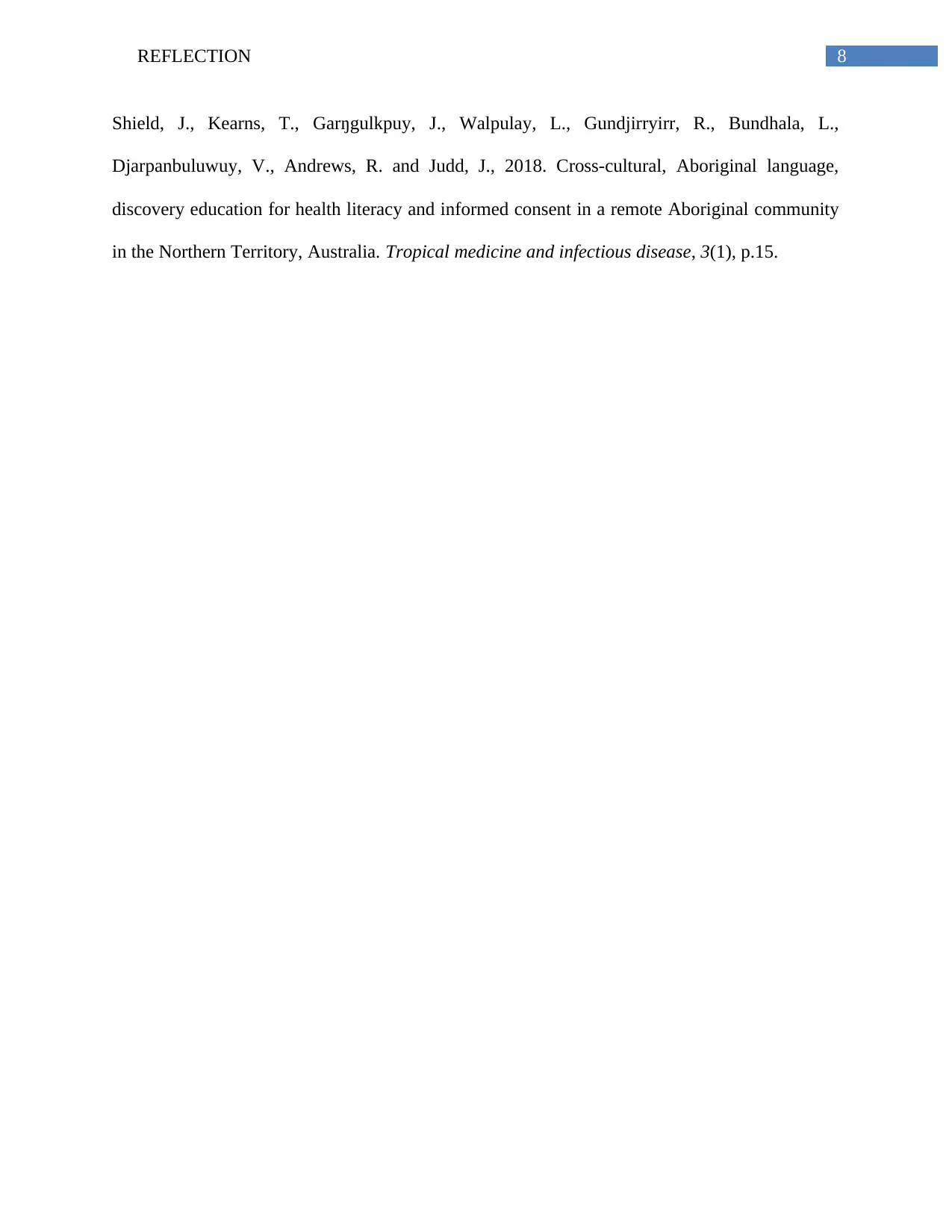
8REFLECTION
Shield, J., Kearns, T., Garŋgulkpuy, J., Walpulay, L., Gundjirryirr, R., Bundhala, L.,
Djarpanbuluwuy, V., Andrews, R. and Judd, J., 2018. Cross-cultural, Aboriginal language,
discovery education for health literacy and informed consent in a remote Aboriginal community
in the Northern Territory, Australia. Tropical medicine and infectious disease, 3(1), p.15.
Shield, J., Kearns, T., Garŋgulkpuy, J., Walpulay, L., Gundjirryirr, R., Bundhala, L.,
Djarpanbuluwuy, V., Andrews, R. and Judd, J., 2018. Cross-cultural, Aboriginal language,
discovery education for health literacy and informed consent in a remote Aboriginal community
in the Northern Territory, Australia. Tropical medicine and infectious disease, 3(1), p.15.
1 out of 9
Related Documents
Your All-in-One AI-Powered Toolkit for Academic Success.
+13062052269
info@desklib.com
Available 24*7 on WhatsApp / Email
![[object Object]](/_next/static/media/star-bottom.7253800d.svg)
Unlock your academic potential
© 2024 | Zucol Services PVT LTD | All rights reserved.





